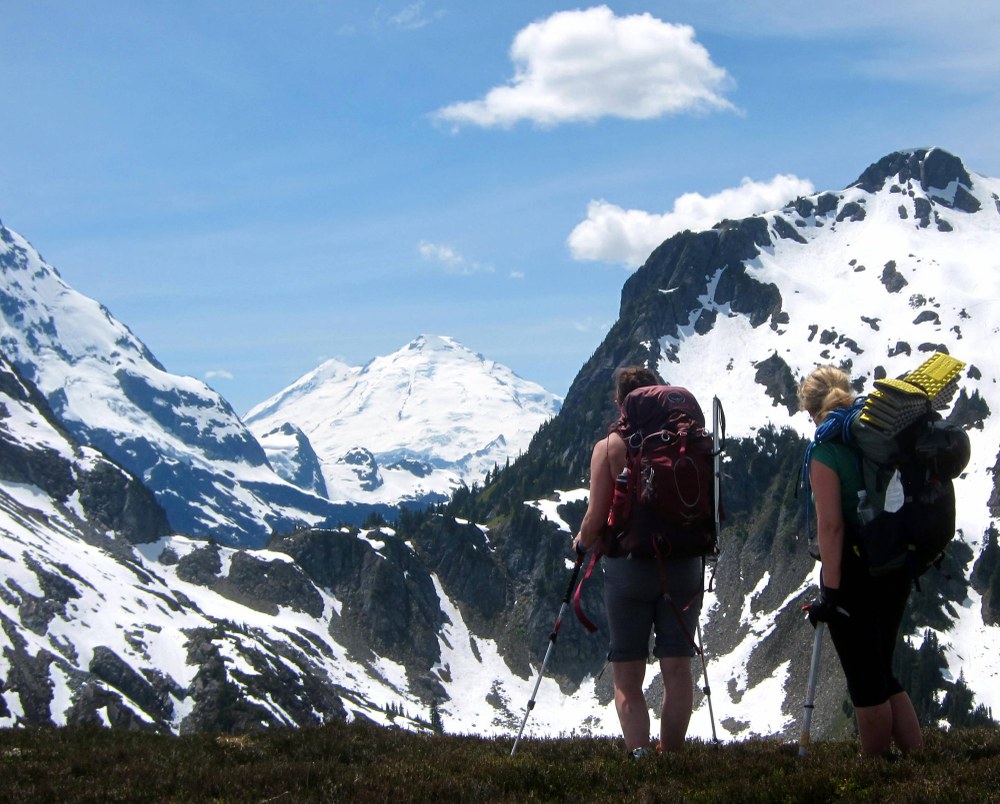
As the summer heat melts the snow in the mountains, more and more patches of exposed rock appear and can be very hazardous for multiple reasons.
Hazards
As the snow melts, it leaves rocks wet and slick. It can be easy to slip - especially if your boots are already wet from walking in the snow.
Dangers can come from above too. When the snow melts, the resulting water seeps down into cracks in the rock. As temperatures drop overnight, this water often refreezes and expands, which can fracture the rock. When the rock starts to heat up in the morning, the water melts and the fractured rocks can splinter and fall down on climbers.
Another major hazard are areas of thin snowpack. A climber from Olympia found this out firsthand when she fell through a patch of thin snow on a descent from Ingalls Peak in the summer of 2014. Luckily, the fall was not severe, and she was able to put on a knee brace and slowly return to the trailhead on her own accord, thanks to help from her fellow teammates and some anti-inflammatories.
Boulder fields, creeks, waterways, and transitional boundaries between rock and snow are all susceptible to having thin, hazardous snow conditions. In boulder fields, we are often crossing these areas to access a rock climb or approach a glacier. As the snow melts away and gets thinner, more of the boulders are exposed. These boulders radiate the heat from the day and melt more of the snow, which helps perpetuate the cycle.
Near waterways, the warm, splashing water erodes the snow from the underneath while the sun bakes from above, creating an ever-thinning snow bridge. And in those transitional areas where you move from rock to snow or vice versa, again it is the rock radiating heat from the day which melts away the snow from the underneath and edges, creating what is referred to as a “moat” at the edge of the rock. Finding a safe way to cross these transitional moats can sometimes be the most difficult part of a climb.
Navigating the Hazards
In all of these instances, it’s hard to know how thick the snow patches are and how much is melted out beneath the surface of the snow. When climbers “punch through” these thin snow layers, the most common injuries are to the knees and ankles - sprains, hyperextensions, torn ligaments, even severe fractures. In the cases of moats, the gaps between snow and rock are often dramatically undercut and can be dozens of feet deep. If one were to fall through, it could mean a severe injury or even death.
Always treat these areas with extreme caution. If crossing a boulder field with patches of snow, try to pick your way through by linking dry, snow-free boulders. If you have to step on the snow, test it first by pushing on it with your trekking pole to see how strong it is.
If you are near water, try to approach by finding areas where the snow first transitions to bare ground before reaching the water. Be cautious of the water undercutting a bank of snow. If you have to cross the waterway over the snow, give the edges of the water a wide berth and keep a reasonable distance. As you are crossing the snow over the water, listen for the sounds of the water rushing underneath the surface of the snow. The more you can hear the water, the thinner the snow will be, so try to pick the most quiet path through.
As with crossing a boulder field, use your trekking poles to test the snow in front of you if you become suspicious of its depth and strength. Waterways with a high volume of flow pose an added risk - not only could you get injured by punching through, you could also get swept down the waterway and now you also run the risk of drowning. If the waterway is still partially covered in snow, you could also get carried under one of these snow-covered areas and be stuck there.
When approaching moats, always look for areas that are still the closest to the face of the rock. Your best bet is to find somewhere that the snow is actually still touching and cross there. Try to plan your timing so that you are crossing when it is early in the morning so you’ll have cooler temperatures and therefore firmer snow. A belay from your partner can help reduce the chances of a major injury if the edge of the moat collapses. The only way to know how thick the snow is at the edge of the moat or how deep it is undercut is to see for yourself. If you are moving from snow to rock, you can lie down on the snow and crawl towards to edge to peek over. Lying down helps disperse your weight over a larger area and reduces your chances of falling through or the edge collapsing. If it is a large moat, sometimes crawling down into it and back up the rock on the other side may be the only way to get past.
In all cases, move through these areas delicately but quickly, and avoid your exposure to these hazards. With these tips in mind, hopefully you’ll be able to avoid these hazards and the often bone-jarring falls that are associated with them.
 James Pierson
James Pierson